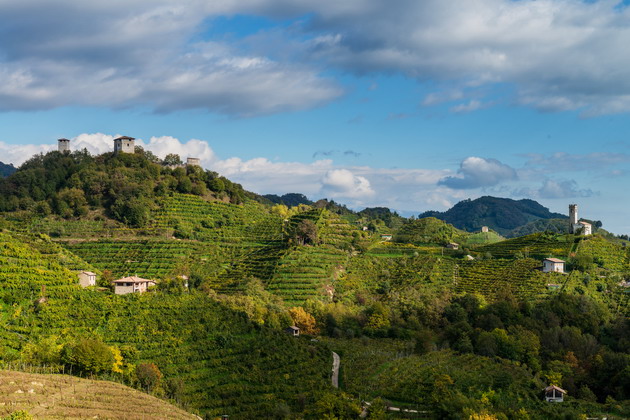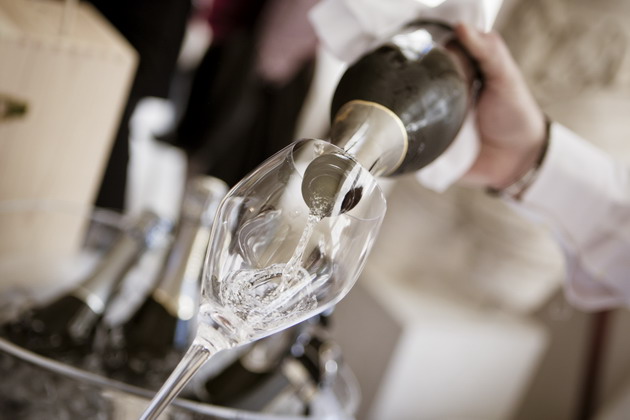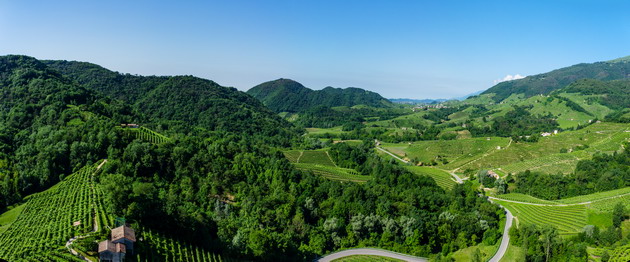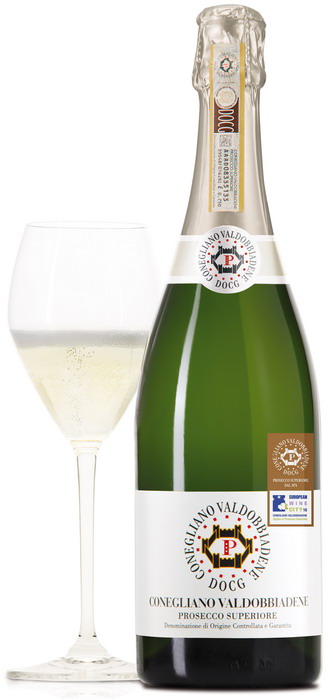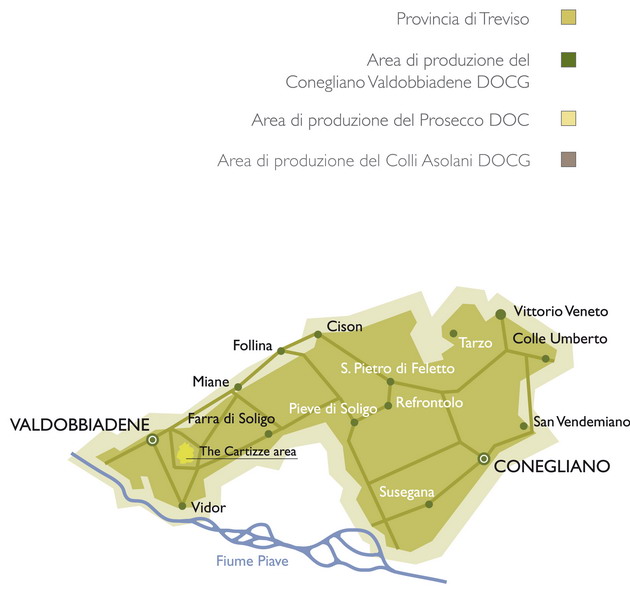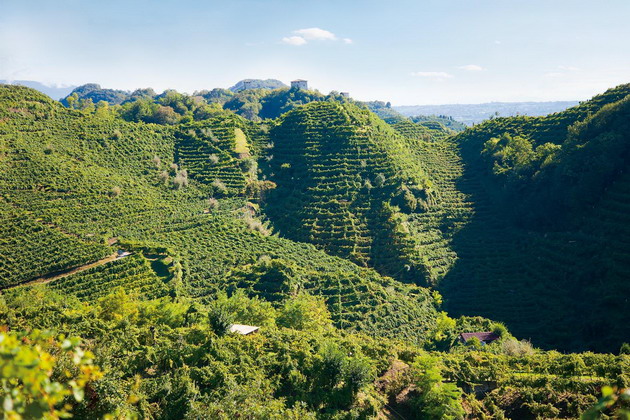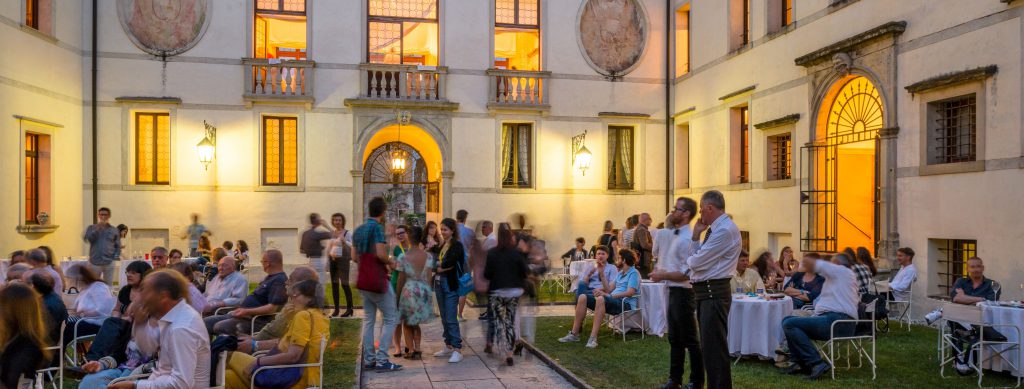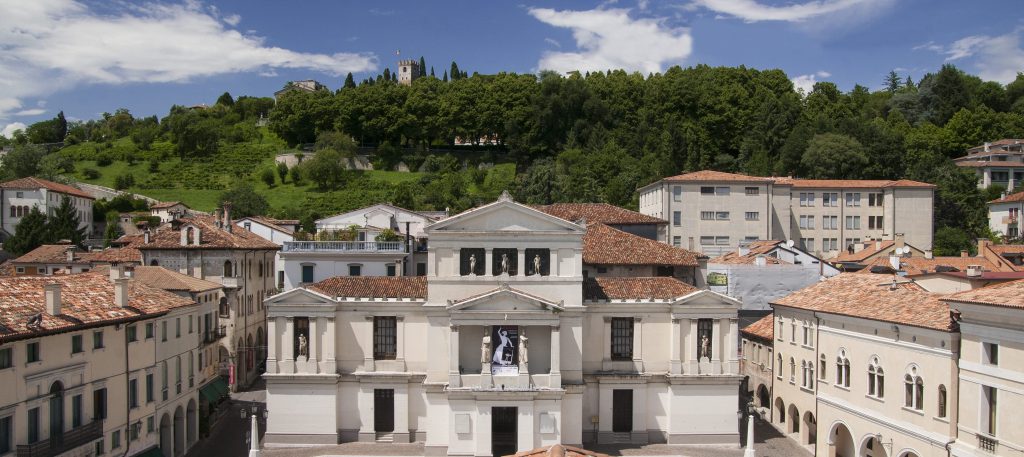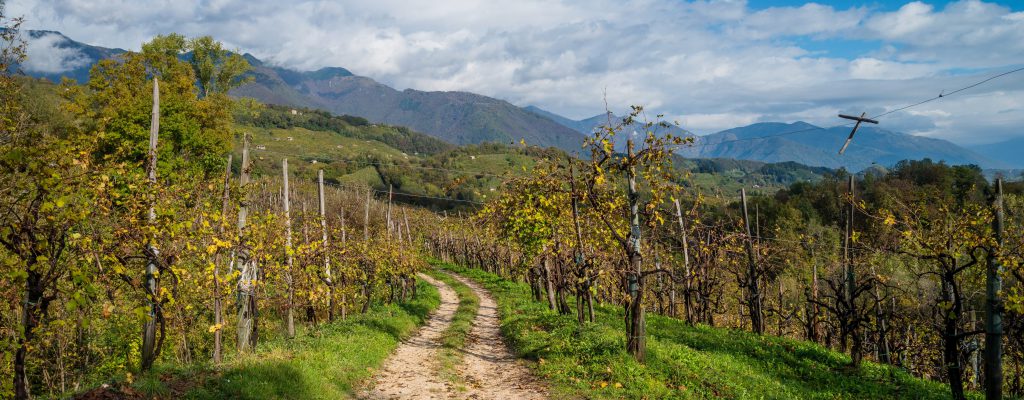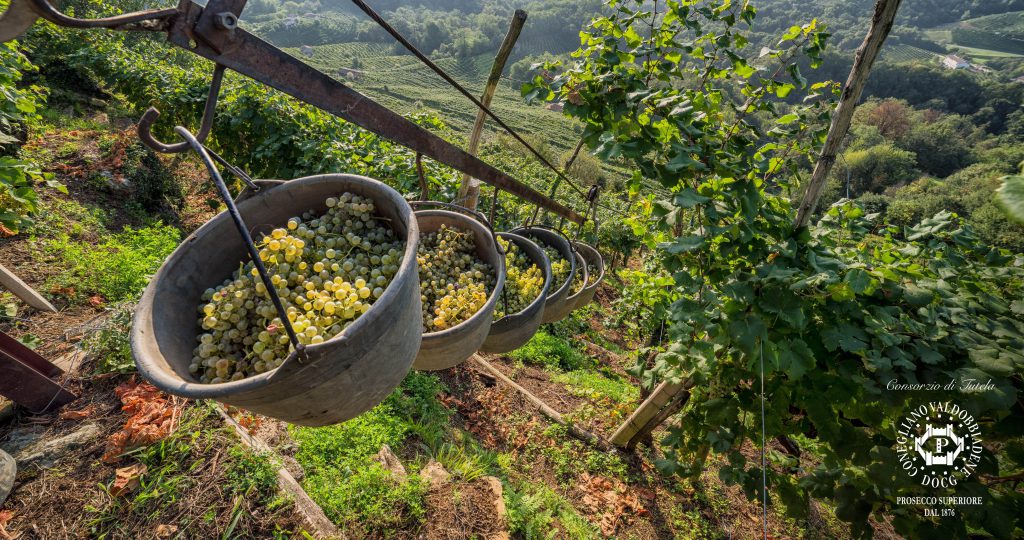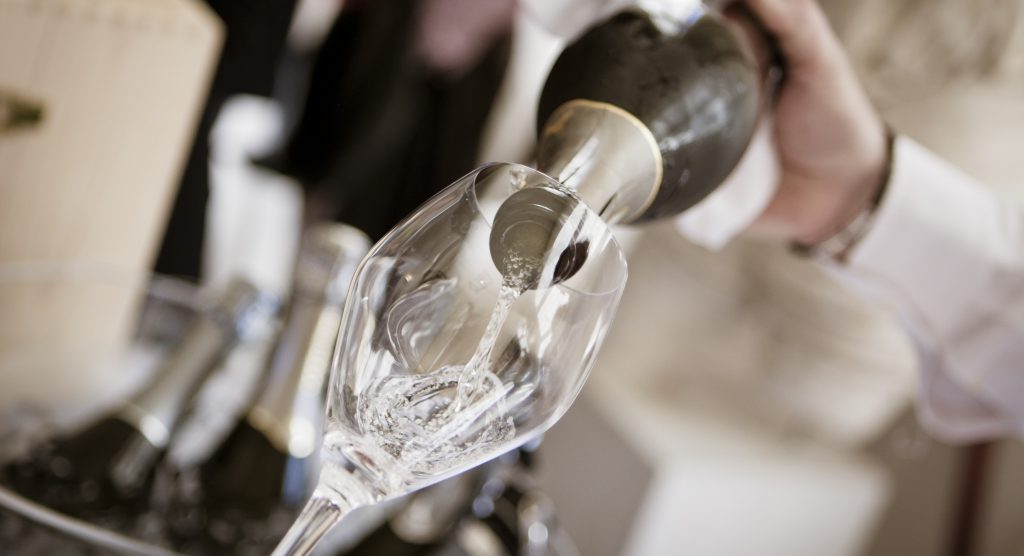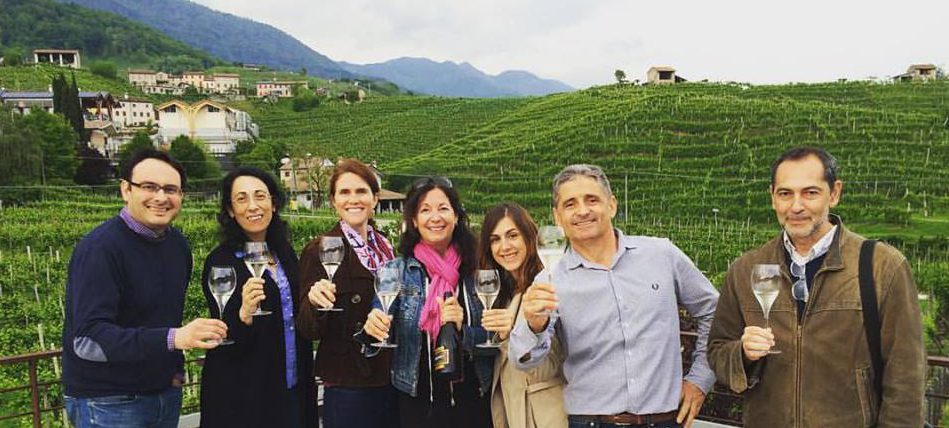In the aftermath of the 2008 financial crisis, Prosecco sales skyrocketed internationally. The popular explanation was that Champagne drinkers were trading down to accommodate shrinking wallets.
This may have been a key factor spurring the initial upswing, but Prosecco sales continue to soar, unmatched by other non-Champagne sparkling wines.
Many attribute Prosecco’s long term success to its vibrantly fruity and uncomplicated style. Others suggest that the refreshingly low alcohol, typically a modest 11 to 11.5%, is the main appeal.
Yet this seems an to be over simplistic analysis. It fails to take into account the incredible expression of terroir in the top, Superiore vineyard sites, and the rich, storied history of Prosecco winemaking.
Up until quite recently, the grape used to make this charming bubbly was called Prosecco. While production centred around the north east of Italy, more and more outlying regions planted Prosecco hoping to cash in on the wine’s growing popularity. This led to a vast disparity in styles and quality levels.
In 2009, the Italian authorities clamped down. The variety was renamed using the historic moniker Glera. The wine resulting from the Glera grape remained Prosecco, but could only be made in a restricted area.
Two quality tiers were thus established: Prosecco DOC from one of 9 provinces in the Veneto and neighbouring Friuli Venezia Giulia, and Prosecco Superiore DOCG from one of two exceptional vineyard areas in the Treviso province of the Veneto (Asolo and Conegliano- Valdobbiadene).
The historical centre, and heartland, of top quality Prosecco Superiore production lies just 50 km due north of Venice, in the foothills of the Prealps. The official name of the appellation is Conegliano Valdobbiadene Prosecco Superiore DOCG.
It is here, amid the breathtaking vineyards that join the towns of Conegliano to Valdobbiadene, that Prosecco Superiore takes on real elegance and finesse. The region boasts a mild, temperate climate with ample rainfall. It was to these cooler hills that the Venetian nobles of yore would retreat in the muggy heat of summer.
While the majority of DOC Prosecco is grown on flat plains that allow for high yields and mechanized vineyard labour, the vines of Conegliano Valdobbiadene are planted on increasingly steep slops as one journeys from the gentle hillsides of Conegliano to the precipitous heights of Valdobbiadene. The higher altitude brings a freshness and delicacy unique to the Prosecco crafted here, clearly demonstrating why it is of DOCG Superiore status.
Furthermore, the sharp inclines also result in lower yields of more concentrated, perfumed grapes. It is said that the vineyards surrounding Conegliano give firmer, more structured, fruit-driven wines due to the heavier, clay soils. Closer to Valdobbiadene, the soil composition varies more widely, ranging from ancient morainic origin, sandstone and clay. The wines are generally considered to have greater finesse, lighter body and a more floral fragrance.
In 2016, the Conegliano Valdobbiadene region was awarded the prestigious title of European Wine City. This is the first time that Recevin, the community-wide network of 1,000 European Wine Towns, selected an entire appellation, rather than a specific town. The beauty and rich history of the area has also led to a petition for status as a UNESCO World Heritage Site.
While the entire region of Conegliano Valdobbiadene is encompassed within one appellation, there exists a hierarchy of quality that singles out the better, and best, vineyard sites. The better vineyards are called ‘Rive’.
This word, along with the name of the hamlet or individual vineyard plot are included on wine labels to highlight the fact to discerning consumers. The Rive were carefully selected for the heightened complexity and concentration of the grapes grown on these lands.
There is but one best, Grand Cru equivalent, vineyard. It is called Cartizze. Perched above Valdobbiadene, this lone hillside represents the finest expression of Prosecco Superiore. A mere 107 hectares are planted here, shared among some 100 grape growers. Each estate lucky enough to own a few rows of vines here cherishes this land like no other.
Cartizze is blessed with a unique microclimate. The southern exposure and steep angles offer maximum sunshine during the day. The high altitude guarantees cool nights, allowing a long, slow ripening period. Most of the Prosecco Superiore produced here is crafted in the ‘Dry’ style, though the zesty acidity and rich, fruit laden flavours make the sweetness almost imperceptible.
The bustling town of Conegliano is the site of the oldest oenology school in Italy, founded in 1876. It was here that the vinification method responsible for Prosecco Superiore’s unique effervescence was conceived.
While many refer to the vinification technique used for Prosecco as the Charmat, or tank method, further refinements exist for Prosecco Superiore. The process of carbonization is therefore differentiated locally, using the term ‘the Conegliano Valdobbiadene method’.
In Conegliano Valdobbiadene, Prosecco Superiore is made with a minimum of 85% Glera. The remainder of the blend can be made up of any of the following local and international varieties:
Verdiso, Bianchetta Trevigiana, Perera, Glera Lunga, Pinot Bianco, Pinot Grigio, Pinot Nero and Chardonnay.
The grapes are handpicked into small crates, gently pressed and then fermented dry. This ‘base wine’ is then dosed with yeast and sugar to spur a secondary fermentation, this time in sealed, pressurized tanks.
The exact recipe for this ‘liqueur de tirage’ is a carefully guarded house secret. With no means of escape, the carbon dioxide bubbles produced dissolve into the wine to form a delicate, frothy mousse.
Bottle fermented sparkling wines like Champagne are often left many months, or even years, to mature on their lees (spent yeast cells) gaining in weight and complexity.
Prosecco Superiore, on the other hand, is bottled rapidly after the second fermentation. The goal is to capture the wine’s youthful charm. Though a few years’ cellaring can reveal intriguing nutty, honeyed qualities, by and large, Prosecco Superiore is not meant to age.
Prosecco Superiore has an almost ethereal quality. Whereas inexpensive DOC Prosecco can be aggressively effervescent, with intense candied pear notes, Prosecco Superiore DOCG is a more refined creature.
Restrained, yet pleasingly complex floral, apple and pear notes are underscored by intriguing hints of exotic spice and hazelnuts. Fresh acidity gives way to a light, smooth texture on the palate. Styles range from bone dry to lusciously sweet.
Sweetness levels are largely based on the ripeness of fruit that can be achieved in different vineyard sites. Grapes from cooler areas, where ripening is marginal at best, are generally fashioned into crisp, light, very dry wines. The sunniest, warmest vineyards are traditionally reserved for the production of rich, heady sweet wines.
The precise terminology used on Prosecco Superiore labels is as follows: Brut wines are dry (0 – 12g/l of residual sugar), Extra Dry wines are, in fact, semi-sweet (12 – 17g/l) and, finally, Dry wines are, surprisingly, sweet (17 – 32g/l).
Regardless of style, Conegliano Valdobbiadene wines are always beautifully balanced. The Brut wines thrill with their racy acidity, delicate structure and vibrant citrus, green apple aromas.
On the other end of the spectrum, the honeyed peach and pear fruit of Dry wines is offset by fresh acidity and vibrant effervescence.
While many see Prosecco Superiore as the quintessential cocktail hour tipple, locals disagree. They drink their famous bubbly from the pre-dinner apéritif right through to dessert.
Brut Prosecco, with its light, zesty style is the perfect accompaniment to vegetable-based appetizers, seafood dishes or baked fish. Extra-Dry Prosecco, rounder and fruitier, pairs well with vegetable or seafood soups, pastas with delicate meat sauces, fresh cheeses and white meats. Finally, the lush, juicy Dry wines are excellent with spicy Asian cuisine or sweet pastries.
Although made to very high quality standards, Prosecco Superiore does not take itself too seriously. It bursts forth with a fresh, easy drinking appeal that lures the drinker back for another sip.
It should be served chilled (6°c to 8°c) and consumed rapidly upon purchase. For your next festive gathering, I highly recommend spending just a few dollars more to upgrade to Conegliano Valdobbiadene Prosecco Superiore DOCG.
If you really want to impress your guests, try a Rive or a Cartizze.
Part II
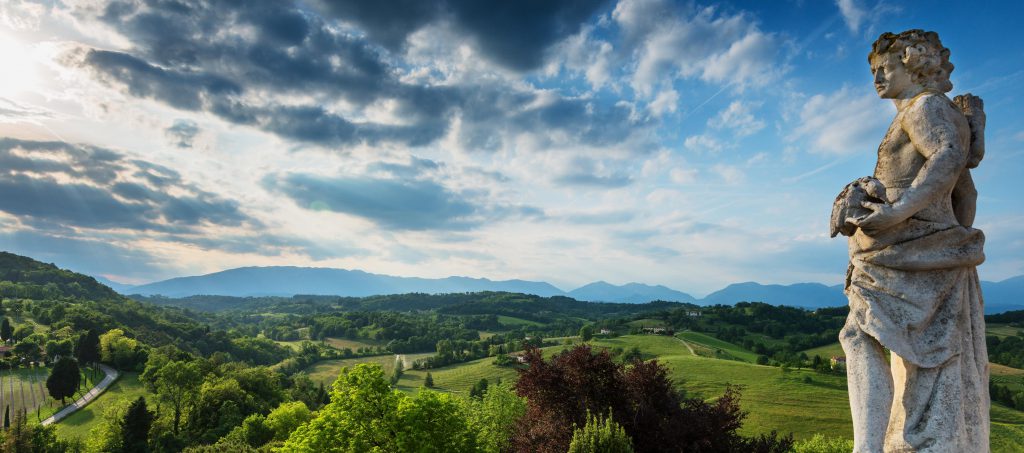 Photos: Consorzio Conegliano Valdobbiadene Prosecco Superiore D.O.C.G.
Photos: Consorzio Conegliano Valdobbiadene Prosecco Superiore D.O.C.G.
By Jacky Blisson
I arrived in Venice, Italy, on May 13th to ominous clouds, but mild spring weather and lush greenery. I was there to join in the revelry of the Vino in Villa festival.
This annual event aims to showcase the superior quality of DOCG Prosecco from the region of Conegliano Valdobbiadene. A smattering of wine journalists from around the globe were gathered to learn more about the region and its famed bubbly.
The goal?
To pass on the good word that Prosecco is more than a cheap and cheerful Champagne alternative.
Prosecco is an Italian sparkling wine made throughout the Veneto and neighbouring Friuli Venezia Giulia regions in North Eastern Italy.
The principle grape is called Glera. Not a particularly memorable variety for still wines due to a fairly neutral character, Glera is an excellent sparkling base. It boasts lively acidity, and peachy, floral notes.
As with many Old World wine regions, there is a quality hierarchy. The lowest tier is Prosecco DOC, which includes grapes grown anywhere in the two above mentioned regions.
Above this tier, we get into the Superiore level, to which this festival pays homage. The official name for this higher quality appellation is: Conegliano Valdobbiadene Prosecco Superiore DOCG (I know, the name just rolls off your tongue, right?).
It can only be made in the Treviso province of Veneto on the rolling hills between the towns of Conegliano and Valdobbiadene. It is here that the Glera grape goes beyond simple, peachy fizz to take on real elegance and charm.
Prosecco can be made dry (brut), slightly off-dry (extra dry), or semi sweet (dry)…yes, the nomenclature is confusing! It can also be still, lightly sparkling (frizzante) or fully sparkling (spumante). The spumante style is most common.
The festival itinerary got off to a very civilized start with a sumptuous lunch. We paired the brisk, refreshing, citrusy and faintly saline Le Manzane “Springo Blue” Conegliano DOCG Prosecco brut with herb sprinkled swordfish tartare & strawberry mayo.
The main course was grilled sturgeon cooked to perfection with a pretty, floral extra dry Valdobbiadene DOCG Prosecco from Agostinetto “Vigna del Baffo”. The smooth, subtly creamy, poached pear finish underscored the rich, textured fish perfectly. All in all, a great start, topped off by a saunter around the lovely 10th century castello and doumo in historic Conegliano.
Day two started at the Conegliano enology school for a proper classroom session on winemaking. The main difference always cited when people compare Champagne with Prosecco, is the vinification method.
Champagne (along with Cava and many other sparkling wines) ferments to completion in tank or barrel like any dry white, and is then transferred to bottle, dosed with sugar and yeast and sealed to undergo a secondary fermentation process whereby carbon dioxide bubbles get trapped in the bottle making the fine mousse we know and love.
For Prosecco, the Italian (or Martinotti) method is employed. The initial vinification is much the same. However, the carbonation process takes place in sealed, pressurized tanks.
Whereas Champagne is deliberately left to mature on its lees (spent yeast cells) to develop weight and complexity, Prosecco is bottled rapidly after the second fermentation. The resultant fizz is softer and frothier with exuberant fruity appeal.
With over 7000 hectares, there is a wealth of diversity – from soil composition, to aspect, to microclimate – leading to important stylistic differences within the Conegliano Valdobbiadene Superiore Prosecco DOCG area.
To see for ourselves, we hopped back on the bus and made our way from the relatively flat plains of Conegliano to the steep slopes surrounding Valdobbiadene.
The stunning Prosecco wine route weaves through sleepy hamlets, up and down increasingly steep hillsides, to reveal a hidden paradise of lush, green vines.
Redder, more clay-rich soils surround Conegliano, giving structured, fruity wines. Nearer to Valdobbiadene, the vines are planted on more ancient morainic, sandstone and clay, yielding more elegant, floral aromatics.
Like the 1er crus of Burgundy, certain vineyard sites have been singled out as superior. They are called “Rive”, followed by the name of the vineyard or hamlet. If you are curious to try a more complex style of Prosecco, look out for this. At the highest point of the appellation, over 400m above sea level, we come across the single Grand Cru hillside: Cartizze. Just 107 hectares of vines are planted here.
With more than 100 different growers, production volumes are tiny. Cartizze is blessed with a special microclimate. The southern exposure and steep angles offer maximum sunshine during the day.
The high altitude guarantees cool nights, allowing a long, slow ripening period. The vast majority of Prosecco produced here is crafted in the “Dry” style (17 – 32g/L residual sugar), though the zesty acidity and rich, fruit laden flavours make the sweetness almost imperceptible.
In Cartizze and the surrounding steep hillsides, wine producers can use the special “Viticoltura Eroica” logo on their label. Literally translated as “heroic viticulture”, this lovely term refers to the impressive lengths to which growers have to go in order to work these precipitous vineyards.
Everything is done by hand here, making pruning, harvest and other vineyard chores a backbreaking labour of love.
Over the next two days we met with growers and visited wineries. I saw everything from modest family affairs to gigantic operations with massive, 200 hectalitres tanks gleaming out in the sun. Over the course of our conversations and tastings the difference between basic Prosecco DOC and premium Conegliano Valdobbiadene Prosecco Superiore DOCG became increasingly apparent.
Much of what we are exposed to outside of Italy is the entry priced, aggressively frothy, candied peach and pear scented concoctions served at cheap banquets. The finer examples of Conegliano Valdobbiadene Prosecco Superiore DOCG shine in comparison.
When you see the steep hillsides, worked entirely by hand around Valdobbiadene, with only half the yield of the flat plains of Prosecco DOC, it is easy to understand why.
The best of the best have much finer mousse, only faintly frothy on the palate, with delicate floral, zesty apple and ripe pear aromas. On the palate, subtle spiced notes of aniseed or ginger are common. Some even offer attractive hazelnut or mineral undertones.
From crisp, bone dry “Extra Brut” to overly fruity “Dry” styles, the top DOCG Proseccos offer balance. The sugar is offset by fresh acidity and vibrant bubbles, with none of the cloying sweetness on the finish.
Prosecco DOCG “should taste like spring time” proclaimed Canavel’s Carlo Caramel (yes, that is his real name). This neatly sums it up for me. Prosecco is meant to be drunk young, in the year following production.
Though we did try a few intriguing 2014s with nutty, honeyed profiles, by and large the wine is not meant to age. Although made up to high quality standards, Prosecco DOCG does not take itself too seriously.
It is bottled young and fresh, and should be drunk upon purchase…preferably on a terrace, with good tunes and great company.
The festivities culminated in a lovely closing dinner. The Prosecco flowed freely, served in the traditional order: Brut with antipastis, Extra Dry with the primi and secondi piatti and Cartizze for the dulce. After 5 courses, we were satiated and feeling merry.
The old, low beamed roof creaked under the weight of hundreds of old copper pots hanging from the rafters. When we asked the charming Ernesto from Marsuret winery what the locals drank other than Prosecco, he cried “Grappa!” at which point liveried sommeliers arrived with snifters of the fiery golden liquid.
My Vino in Villa experience was at its end, but the memories will surely linger on.
Some great producers to look for:
Adami, Biancavigna, Bisol, Canevel, Foss Marai, Malibran, Marchiori, Marsuret, Merotto, Ruggeri, Villa Sandi
Jacky Blisson
Master of Wine Candidate
Jacky Blisson is a second stage Masters of Wine (MW) student. She spent 10 years in France studying and selling the wines of Burgundy and the Rhône Valley.
Now she is back in her hometown of Montréal with a dapper French oenologist husband and rowdy toddler in tow.
Her modest winemaking experience includes harvest and cellar seasons in both Burgundy and the Walker Bay, South Africa.
Jacky’s passions in life are wine, food, travel and (according to her family) talking – hence her latest foray into wine writing and education.
To find out more, check out Jacky’s blog at www.jackyblisson.com.
CAMPAIGN FINANCED ACCORDING TO (EC) REGULATION NO.1308/2013


